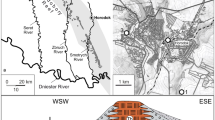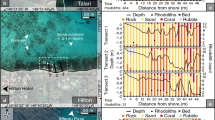Abstract
We used the elemental signatures in otoliths of the damselfish Pomacentrus coelestis as a proxy for conditions experienced prior to settlement. Fish from the southern Great Barrier Reef (GBR) differed in their pre-settlement otolith chemistry, indicating that they had occupied different water masses during their pelagic stage, thus suggesting multiple larval sources. Fish from reefs in the northern GBR did not differ greatly in their pre-settlement otolith chemistry, suggesting a single larval source. Using “near-natal” signatures, we determined that ~67% of these signatures matched the signature established for Lizard Island (LZ), suggesting LZ could be a source reef. However, these results could also be the result of poor separation among reefs caused by reefs sharing water masses. Otolith chemistry also revealed that 50–70% of all fish examined settled on the reef the day they encountered it, while some fish spent up to 4 days near the reef prior to settlement.



Similar content being viewed by others
References
Booth DJ, Beretta GA (1994) Seasonal recruitment, habitat associations and survival of pomacentrid reef fish in the US Virgin Islands. Coral Reefs 13:81–89
Booth DJ, Wellington G (1998) Settlement preferences in coral-reef fishes: effects on patterns of adult and juvenile distributions, individual fitness and population structure. Aust J Ecol 23:274–279
Booth DJ, Kingsford MJ, Doherty PJ, Beretta GA (2000) Recruitment of damselfishes in One Tree Island lagoon: persistent interannual spatial patterns. Mar Ecol Prog Ser 202: 219–230
Brophy D, Jeffries TE, Danilowicz BS (2004) Elevated manganese concentrations at the cores of clupeid otoliths: possible environmental, physiological, or structural origins. Mar Biol 144:779–786
Bruland KW (1983) Trace elements in sea-water. In: Riley JP, Chester R (eds) Chemical oceanography, vol 8. Academic, London, pp 157–215
Caley MJ, Carr MH, Hixon MA, Hughes TP, Jones GP, Menge BA (1996) Recruitment and the local dynamics of open marine populations. Ann Rev Ecol Syst 27:477–500
Cowen RK, Lwiza KMM, Sponaugle S, Paris CB, Olson DB (2000) Connectivity of marine populations: open or closed? Science 287:857–859
Doherty PJ, Williams DM (1988) The replenishment of coral reef fish populations. Oceanogr Mar Biol Ann Rev 26:487–551
Doherty PJ, Kingsford MJ, Booth D, Carleton J (1996) Habitat selection before settlement by Pomacentrus coelestis. Mar Freshw Res 47: 391–399
Eggins SM, Kinsley LPJ, Shelley JMG (1998) Deposition and fractionation processes during atmospheric pressure laser sampling for analysis by ICP-MS. Appl Surf Sci 127–129:278–286
Fisher R, Bellwood DR, Job SD (2000) Development of swimming abilities in reef fish larvae. Mar Ecol Prog Ser 202:163–173
Flood MJ (2000) Otolith microstructure in pre- and post-settlement Pomacentrus coelestis (Pisces: Pomacentridae). Honours Thesis, University of Sydney
Gillanders BM (2002) Connectivity between juvenile and adult fish populations: do adults remain near their recruitment estuaries? Mar Ecol Prog Ser 240:215–223
Gillanders BM, Kingsford MJ (1996) Elements in otoliths may elucidate the contribution of estuarine recruitment to sustaining coastal reef populations of a temperate reef fish. Mar Ecol Prog Ser 141:13–20
Gillanders BM, Kingsford MJ (2000) Elemental fingerprints of otoliths may distinguish estuarine “nursery” habitats. Mar Ecol Prog Ser 201:273–286
James MK, Armsworth PR, Mason LB, Bode L (2002) The structure of reef fish metapopulations: modelling larval dispersal and retention patterns. Proc R Soc Lond B Biol Sci 269: 2079–2086
Jones GP, Milicich MJ, Emslie MJ, Lunow C (1999) Self-recruitment in a coral reef fish population. Nature 402:802–804
Kingsford MJ (2001) Dial patterns of abundance of presettlement reef fishes and pelagic larvae on a coral reef. Mar Biol 138:853–867
Kingsford MJ, Choat JH (1989) Horizontal distribution patterns of presettlement reef fish: are they influenced by the proximity of reefs? Mar Biol 100:285–297
Kingsford MJ, Leis JM, Shanks A, Lindeman KC, Morgan SG, Pineda J (2002) Sensory environments, larval abilities and local self-recruitment. Bull Mar Sci 70:309–340
Leis JM (1986) Vertical and horizontal distribution of fish larvae near coral reefs at Lizard Island, Great Barrier Reef. Mar Biol 90:505–516
Leis JM (1991) The pelagic stage of reef fishes: the larval biology of coral reef fishes. In: Sale PF (ed) The ecology of fishes on coral reefs. Academic, San Diego, pp 183–230
Leis JM (2002) Pacific coral-reef fishes: the implications of behaviour and ecology of larvae for biodiversity and conservation, and a reassessment of the open population paradigm. Environ Biol Fish 65:199–208
Leis JM, Carson-Ewart BM (1997) In situ swimming speeds of the late pelagic larvae of some Indo-Pacific coral-reef fishes. Mar Ecol Prog Ser 159:165–174
Leis JM, Carson-Ewart BM (eds) (2000) The larvae of Indo-Pacific coastal fishes: an identification guide to marine fish larvae, 1st edn. Brill, Boston
Leis JM, Goldman B (1987) Composition and distribution of larval fish assemblages in the Great Barrier Reef lagoon, near Lizard Island, Australia. Aust J Mar Freshw Res 38:211–223
Milicich MJ, Doherty PJ (1994) Larval supply of coral reef fish populations: magnitude and synchrony of replenishment to Lizard Island, Great Barrier Reef. Mar Ecol Prog Ser 110:121–134
Milicich MJ, Meekan MG, Doherty PJ (1992) Larval supply: a good predictor of recruitment of three species of reef fish (Pomacentridae). Mar Ecol Prog Ser 86:153–166
Patterson HM, Thorrold SR, Shenker JM (1999) Analysis of otolith chemistry in Nassau grouper (Epinephelus striatus) from the Bahamas and Belize using solution-based ICP-MS. Coral Reefs 18:171–178
Patterson HM, Kingsford MJ, McCulloch MT (2004) Elemental signatures of Pomacentrus coelestis otoliths at multiple spatial scales on the Great Barrier Reef, Australia. Mar Ecol Prog Ser 270:229–239
Pulliam HR (1988) Sources, sinks, and population regulation. Am Nat 132:652–661
Quinn GP, Keough MJ (2002) Experimental design and data analysis for biologists. Cambridge University Press, Cambridge
Robertson DR, Green DG, Victor BC (1988) Temporal coupling of reproduction and recruitment of larvae of a Caribbean reef fish. Ecology 69:370–380
Roughgarden J, Gaines S, Possingham H (1988) Recruitment dynamics in complex life cycles. Science 241:1460–1466
Secor DH, Henderson-Arzapalo A, Piccoli PM (1995) Can otolith microchemistry chart patterns of migration and habitat utilization in anadromous fishes? J Exp Mar Biol Ecol 192:15–33
Secor DH, Ohta T, Nakayama K, Tanaka M (1998) Use of otolith microanalysis to determine estuarine migrations of Japanese sea bass Lateolabrax japonicus distributed in the Ariake Sea. Fish Sci 64:740–743
Shenker JM, Maddox ED, Wishinski E, Thorrold SR, Smith N (1993) Onshore transport of settlement-stage Nassau grouper (Epinephelus striatus) and other fishes in Exuma Sounds, Bahamas. Mar Ecol Prog Ser 98:31–43
Sponaugle S, Cowen RK (1997) Early life history traits and recruitment patterns of Caribbean wrasses (Labridae). Ecol Monogr 67:177–202
Swearer SE, Caselle JE, Lea DW, Warner RR (1999) Larval retention and recruitment in an island population of a coral-reef fish. Nature 402:799–802
Sweatman HPA (1985) The influence of adults of some coral reef fishes on larval recruitment. Ecol Monogr 55:469–485
Thorrold SR, Jones CM, Swart PK, Targett TE (1998) Accurate classification of juvenile weakfish (Cynoscion regalis) to estuarine nursery areas based on chemical signatures in otoliths. Mar Ecol Prog Ser 173: 253–265
Thorrold SR, Latkoczy C, Swart PK, Jones CM (2001) Natal homing in a marine fish metapopulation. Science 291:297–299
Thorrold SR, Jones GP, Hellberg ME, Burton RS, Swearer SE, Neigel JE, Morgan SG, Warner RR (2002) Quantifying larval retention and connectivity in marine populations with artificial and natural markers. Bull Mar Sci 70(Suppl):291–308
Underwood AJ, Petraitis PS (1993) Structure of intertidal assemblages in different locations: how can local processes be compared? In: Ricklefs R, Schultz D (eds) Species diversity in ecological communities. University of Chicago Press, Chicago, pp 38–51
Wellington GM, Victor BC (1989) Planktonic larval duration of one hundred species of Pacific and Atlantic damselfishes (Pomacentridae). Mar Biol 101:557–567
Wellington GM, Victor BC (1992) Regional differences in duration of the planktonic larval stage of reef fishes in the eastern Pacific Ocean. Mar Biol 113:491–498
Williams DM, English S (1992) Distribution of fish larvae around a coral reef: direct detection of a mesoscale, multi-specific patch? Cont Shelf Res 12:923–937
Wilson DT, McCormick MI (1999) Microstructure of settlement-marks in the otoliths of tropical reef fishes. Mar Biol 134:29–41
Acknowledgements
We thank the staff of the Lizard Island and One Tree Island Research Stations, as well as J. Browne, I. Carlson, S. Burgess, J. Eagle, J. Hughes, A. Abdulla, R. Pears, R. Kelley, and the crew of the M.V. ‘James Cook’ for assistance in the field. M. Shelley, D. Sinclair, L. Kinsley, S. Fallon, T. Wyndham, and S. Eggins provided assistance with the LA-ICP-MS. Statistical advice was provided by M. Sheaves and B. Gillanders. Comments by J. Leis and two anonymous reviewers improved the manuscript. This study was conducted while H.M.P. held a Lizard Island Doctoral Fellowship from the Australian Museum. A CRC Reef Research Grant, Great Barrier Reef Marine Park Authority Augmentative Research Grant, and a grant from the Lerner-Gray Fund for Marine Research from the American Museum of Natural History to H.M.P., and an ARC Large Grant, and a grant from the National Geographic Committee for Research and Exploration to M.J.K. provided additional funding. This study complies with the laws of Australia.
Author information
Authors and Affiliations
Corresponding author
Additional information
Communicated by Ecological Editor Peter Sale
Rights and permissions
About this article
Cite this article
Patterson, H.M., Kingsford, M.J. & McCulloch, M.T. Resolution of the early life history of a reef fish using otolith chemistry. Coral Reefs 24, 222–229 (2005). https://doi.org/10.1007/s00338-004-0469-8
Received:
Accepted:
Published:
Issue Date:
DOI: https://doi.org/10.1007/s00338-004-0469-8




